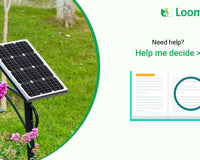From smartphones to electric cars to home energy storage devices, rechargeable batteries power our modern lives. But have you ever stopped to wonder what's inside these devices that allow us to send emojis, drive around town and so much more? If so, check out the Advanced Battery Facility.
The facility is one of a very few experimental battery manufacturing labs that are available to help academia and industry develop and test new batteries. Most of these places are owned by private companies that keep their proprietary tests under wraps, but a few DOE labs — Pacific Northwest National Laboratory, Oak Ridge National Laboratory and Argonne National Laboratory — operate more open facilities so the results can often be made public.
Perfect Energy Storage
2 times battery life, consumes 50% less space, needs no maintenance & takes 60% less recharge time
PNNL's semi-automated Advanced Battery Facility enables scientists to test out all kinds of different materials — including lithium-metal, sulfur, sodium and magnesium — to make batteries last longer and store more energy. The tests are helping scientists from national labs, universities and industry find lower-cost replacements for today's most common rechargeable battery, the lithium-ion battery.
At the Advanced Battery Facility, scientists test-drive new materials by assembling them into cell phone-sized experimental batteries, called "pouch cells" because they're enclosed in a vacuum-sealed plastic pouch. Like full-sized batteries, each pouch cell has three main parts: two electrodes and an electrolyte that separates them.
When the battery stores and later gives up electricity, tiny charged particles move back and forth between each electrode, passing through the electrolyte along the way. This process provides the electricity we need to watch cat videos on our phones, zip around town in electric cars and even store renewable energy for a rainy day.
So how do all these parts get assembled? Here are the seven most important steps in the process:
Step 1: Electrode Slurry: Powders containing the active materials in electrodes (such as lithium) are mixed in a big bowl with binding materials (which act like a glue) to create what scientists call a slurry, or a gooey batter.
Step 2: Electrode Coating: The slurry is then spread out onto a very long (up to a few hundred feet) piece of foil, which slowly rolls through high heat (up to 300 degrees Fahrenheit) to bake the electrode into a solid.
Step 3: Electrode Stamping: The baked electrode roll is cut into smaller pieces, which are placed under a super-sharp, rectangular die. With a sudden movement, the die quickly pushes down on the electrode sheet and cuts out an individual electrode battery piece.
Step 4: Electrode Stacking: An automated machine uses suction to pick up and release sheets of cut-out electrode material and wrap an insulating layer in between each sheet. The result is a credit card-sized electrode stack, which is spit out of the machine with the turn of a metal arm.
Step 5: Pouch Making: A special, moisture-resistant barrier material is pressed to create rectangular forms. An electrode stack is inserted into the resulting form to create a pouch cell.
Step 6: Electrolyte Injection: Liquid electrolyte is injected into an open battery pouch.
Step 7: Battery Sealing: The electrolyte-soaked battery pouch is heat-sealed and placed in a vacuum chamber, which removes excess air from inside the pouch.
How to make a Lithium Battery?
Step 1: Lithium Cells Grading
Step 2: Lithium Cells Charging
Step 3: Lithium Cells Stacking
Step 4: Spot Welding
Step 5: Connecting BMS
Step 6: Insulating Materials
Step 7: Connecting Battery Terminals
Step 8: Packing Battery
Step 9: Branding & Technical Specs
Step 10: Quallity Test & Ready to Use
Such pouch cells are then put through the paces, continually charged and discharged within environmentally controlled chambers that mimic extreme weather (between 20 and -140 degrees Fahrenheit) for at least two weeks.
If a test pouch cell performs well, its unique combination of different materials could enable all of us to power our lives longer and better. When a promising battery chemistry is identified, national labs work with private companies to license the technology, which the companies develop into a product all of us can buy and use.
Source: www.pnnl.gov












